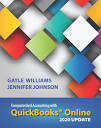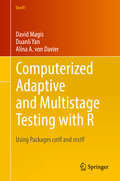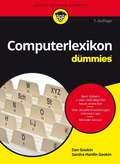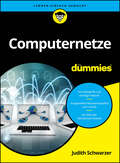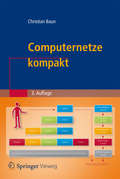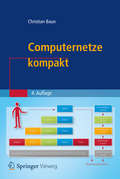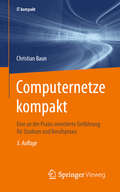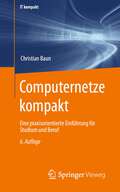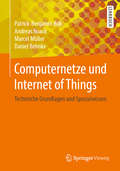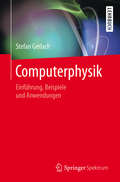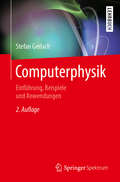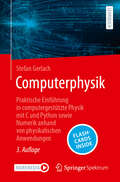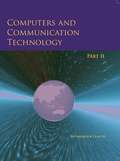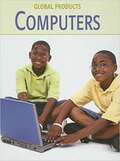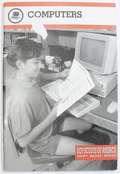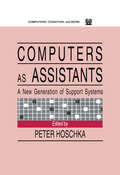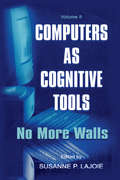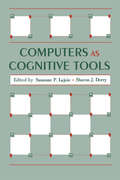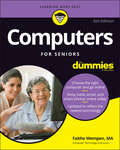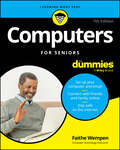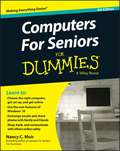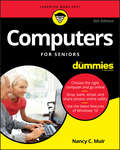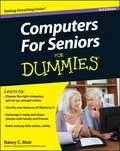- Table View
- List View
Computerized Accounting With Quickbooks 2018
by Gayle WilliamsWelcome to Computerized Accounting with QuickBooks 2018. I wrote this book to give students an introduction to QuickBooks that focuses not only on the soft¬ware mechanics, but also on the basic accounting concepts that underlie all ac¬counting systems. This book is not meant to be a user manual. It is meant to teach students how they can work with a computerized accounting system. It is my intention that students will come away from this book with an understanding that it is knowledge of the principles of accounting, not data-entry skills, that is needed to be successful in business.
Computerized Accounting with QuickBooks® Online 2020 Update
by Jennifer Johnson Gayle WilliamsWelcome to Computerized Accounting with QuickBooks Online. We wrote this book to give students an introduction to QuickBooks Online that focuses not only on the software mechanics, but also on the basic accounting concepts that underlie all accounting systems.
Computerized Adaptive and Multistage Testing with R: Using Packages catR and mstR (Use R!)
by Duanli Yan David Magis Alina A. von DavierThe goal of this guide and manual is to provide a practical and brief overview of the theory on computerized adaptive testing (CAT) and multistage testing (MST) and to illustrate the methodologies and applications using R open source language and several data examples. Implementation relies on the R packages catR and mstR that have been already or are being developed by the first author (with the team) and that include some of the newest research algorithms on the topic. The book covers many topics along with the R-code: the basics of R, theoretical overview of CAT and MST, CAT designs, CAT assembly methodologies, CAT simulations, catR package, CAT applications, MST designs, IRT-based MST methodologies, tree-based MST methodologies, mstR package, and MST applications. CAT has been used in many large-scale assessments over recent decades, and MST has become very popular in recent years. R open source language also has become one of the most useful tools for applications in almost all fields, including business and education. Though very useful and popular, R is a difficult language to learn, with a steep learning curve. Given the obvious need for but with the complex implementation of CAT and MST, it is very difficult for users to simulate or implement CAT and MST. Until this manual, there has been no book for users to design and use CAT and MST easily and without expense; i. e. , by using the free R software. All examples and illustrations are generated using predefined scripts in R language, available for free download from the book's website.
Computerlexikon für Dummies (Für Dummies)
by Dan Gookin Sandra Hardin GookinKennen Sie das? Sie unterhalten sich mit einem Fachmann über Computer oder Smartphones und verstehen nur Bahnhof? In "Computerlexikon für Dummies" finden Sie über 2500 Begriffe aus der Computerwelt, leicht verständlich erklärt und auf den Punkt gebracht, von A wie Abbrechen über M wie Multitouch bis zu Z wie Zylinder (eines Festplattenlaufwerks). Die 7., überarbeitete und aktualisierte Auflage enthält zudem viele neue Begriffe, die die Entwicklung der letzten Jahre mit sich gebracht hat - zum Beispiel zum Datenschutz, zu Windows 10 und zu Trends wie Pokemon Go und Fitness Tracker.
Computernetze für Dummies (Für Dummies)
by Judith SchwarzerWas sich Computer so zu erzählen haben und wer da sonst noch mitredet Computernetzwerke sind grundlegend für die digitale Kommunikation und die gemeinsame Nutzung von Ressourcen in einem Datennetzwerk. Wie ein Computernetzwerk aufgebaut ist, wie es funktioniert und welche Modelle und Regelwerke dem zugrunde liegen, erfahren Sie in diesem Buch. Die Autorin erläutert unter anderem bekannte Anwendungen des Internets mit wichtigen Kommunikationsabläufen gängiger Netzwerkprotokolle, wie IP, TCP, Ethernet und WLAN. Das Buch vermittelt ein tiefgreifendes Verständnis der wichtigsten Netzwerkabläufe und macht Sie fit für die Internet-Technologien der Zukunft. Sie erfahren Wie die wichtigsten Netzwerkprotokolle und -komponenten zusammenspielen Wie das Internet-Protokoll in der Version 4 und 6 funktioniert Wie aus IP-Paketen physikalische Übertragungssignale werden Was Netzwerke sicher, zuverlässig und mobil macht
Computernetze kompakt (IT kompakt)
by Christian BaunDas Werk bietet einen umfassenden Überblick über Computernetzwerke und die wichtigsten Technologien. Der Autor orientiert sich dabei am Schichtenmodell der Internationalen Organisation für Normung und behandelt für jede Schicht die jeweiligen Geräte und Protokolle. Dazu zählen auch Netzwerktechnologien wie z. B. Ethernet, WLAN, Bluetooth sowie Übertragungsmedien. Das Werk vermittelt Lesern ein fundiertes Verständnis von Computernetzwerken - in kompakter Form und in klaren Zusammenhängen.
Computernetze kompakt (IT kompakt)
by Christian BaunComputernetzwerke ermöglichen die Kommunikation der darin zusammengeschlossenen Systeme untereinander. Das Buch vermittelt grundlegendes Wissen über die Funktionsweise moderner Computernetze und deren verschiedenen Komponenten.Ausgehend von einführenden Kapiteln zur Informationstechnik (IT) und zur Computervernetzung erläutert der Autor zunächst die Grundlagen von Protokollen und deren Einordnung in etablierte Referenzmodelle. In diesem Kapitel wird außerdem der Ablauf der Kommunikation im Computernetzwerk und der Weg beschrieben, den die Nutzdaten durch die einzelnen Protokollschichten nehmen. Den einzelnen Schichten der Netzarchitektur, von der untersten Schicht, der Bitübertragungsschicht, bis zur obersten Schicht, der Anwendungsschicht, sind dann die folgenden fünf Kapitel gewidmet. Zu den behandelten Protokollen gehören Netzwerktechnologien wie Ethernet, WLAN, Bluetooth sowie die jeweiligen Übertragungsmedien. Ein eigenes Kapitel führt in die Netzwerkvirtualisierung mit VPNs und VLAN ein. Am Schluss des Buchs finden Leser eine Übersicht über die wichtigsten Kommandozeilenwerkzeuge, die benötigt werden, um Netzwerke zu konfigurieren und Netzwerkprobleme zu analysieren.Das Buch erscheint in der Reihe „IT kompakt“. Diese Werke zu wichtigen Konzepten und Technologien der IT-Branche zeichnen sich dadurch aus, dass sie die Themen fundiert und zugleich praxisorientierten darstellen. Ziel des Buches ist daher eine an der Realität orientierte Beschreibung von Computernetzwerken, die die wichtigsten Technologien in einem klaren Zusammenhang und anhand von aussagekräftigen Beispielen und vielen Abbildungen behandelt. Die vierte Auflage wurde durchgängig aktualisiert und korrigiert. Neu hinzugekommen sind unter anderem Abschnitte zu den Themen IPv6 und HTTP/2.
Computernetze kompakt: Eine an der Praxis orientierte Einführung für Studium und Berufspraxis (IT kompakt)
by Christian BaunDas Werk bietet einen kompakten Überblick über das Thema Computernetzwerke. Sein Aufbau orientiert sich an den Schichten der etablierten Referenzmodelle und behandelt für jede Schicht die Geräte, Nachrichtenformate, Art und Weise der Adressierung und die wichtigsten Protokolle. Zu den Protokollen gehören auch Netzwerktechnologien wie Ethernet, WLAN (WiFi), Bluetooth usw. und die Übertragungsmedien. Ziel des Buches ist keine Auflistung von Algorithmen, sondern eine an der Realität orientierte Beschreibung, die die wichtigsten Technologien in einem klaren Zusammenhang behandelt. Das Buch vermittelt dem Leser ein fundiertes Verständnis von Computernetzwerken in kompakter Form anhand vieler aussagekräftiger Beispiele und Abbildungen. Die fünfte Auflage wurde durchgängig aktualisiert und korrigiert.
Computernetze kompakt: Eine praxisorientierte Einführung für Studium und Beruf (IT kompakt)
by Christian BaunDas Werk bietet einen kompakten Überblick über das Thema Computernetzwerke. Sein Aufbau orientiert sich an den Schichten der etablierten Referenzmodelle und behandelt für jede Schicht die Geräte, Nachrichtenformate, Art und Weise der Adressierung und die wichtigsten Protokolle. Zu den Protokollen gehören auch Netzwerktechnologien wie Ethernet, WLAN (WiFi), Bluetooth usw. und die Übertragungsmedien. Ziel des Buches ist keine Auflistung von Algorithmen, sondern eine an der Realität orientierte Beschreibung, die die wichtigsten Technologien in einem klaren Zusammenhang behandelt. Das Buch vermittelt dem Leser ein fundiertes Verständnis von Computernetzwerken in kompakter Form anhand vieler aussagekräftiger Beispiele und Abbildungen. Die sechste Auflage wurde durchgängig aktualisiert und korrigiert.
Computernetze und Internet of Things: Technische Grundlagen und Spezialwissen
by Patrick-Benjamin Bök Andreas Noack Marcel Müller Daniel BehnkeDieses Buch vermittelt die technischen Grundlagen von Computernetzen. Neben den Aspekten physikalischer und logischer Kommunikation in verteilten Systemen zeigt es den Bezug zur anwendungsorientierten Kommunikation in Computernetzen und im Internet of Things. Unterscheidung und Zusammenhänge von physikalischer, logischer sowie anwendungsorientierter Kommunikation für verteilte Anwendungen und das Internet of Things werden erklärt und Techniken für das Performance Engineering in Computernetzen unter Berücksichtigung von Algorithmen und Protokollen erläutert. Durch seine gute Didaktik und viele Übungsaufgaben ist das Buch sowohl zur Vorlesungsbegleitung als auch für das Selbststudium optimal geeignet.
Computerphysik: Einführung, Beispiele und Anwendungen
by Stefan GerlachDieses Lehrbuch bietet dem Leser eine aktuelle Einführung in das Lösen von physikalischen Problemen mit dem Computer. Es werden die Grundlagen der Computernutzung, der Programmierung sowie der wichtigsten numerischen Methoden besprochen und anhand vieler Beispiele und Übungsaufgaben mit zunehmendem Bezug zur Physik verdeutlicht. Die Nutzung des Betriebssystems Linux und die Programmierung in C und Python bilden dabei den Schwerpunkt. Der wichtigste Teil des Buches sind die Projekte, in denen die zuvor besprochenen Grundlagen auf unterschiedliche Probleme der Physik angewendet werden. Die Projekte umfassen viele wichtige Beispiele aus der Computerphysik (u. a. den Oszillator und Anfangswertprobleme) und diskutieren deren Anwendungen im Detail. Der Leser erhält damit das nötige Rüstzeug, um selbstständig physikalische Probleme mit Hilfe des Computers zu lösen. Zahlreiche Übungsaufgaben helfen dabei.
Computerphysik: Einführung, Beispiele und Anwendungen
by Stefan GerlachDieses Lehrbuch bietet dem Leser eine aktuelle Einführung in das Lösen von physikalischen Problemen mit dem Computer. Die Grundlagen der Computernutzung, der Programmierung sowie der wichtigsten numerischen Methoden werden besprochen und anhand vieler Beispiele und Übungsaufgaben mit zunehmendem Bezug zur Physik verdeutlicht. Die Nutzung des Betriebssystems Linux und die Programmierung in C und Python bilden dabei die Schwerpunkte.Der wichtigste Teil des Buches umfasst die Projekte, in denen die zuvor besprochenen Grundlagen auf unterschiedliche Probleme der Physik angewendet werden. Die Projekte beinhalten viele wichtige Beispiele aus der Computerphysik (u.a. den Oszillator und Anfangswertprobleme) und diskutieren deren Anwendungen im Detail. Der Leser erhält damit das nötige Rüstzeug, um selbstständig physikalische Probleme mithilfe des Computers zu lösen. Zahlreiche Übungsaufgaben unterstützen beim Vertiefen des Erlernten.Neben einer Vielzahl an kleinen Ergänzungen und Verbesserungen ist die zweite Auflage um ein zusätzliches Projektkapitel zum Thema Daten- und Signalanalyse erweitert, wobei wichtige Themen wie statistische Methoden, Filtermethoden und Bildanalyse behandelt werden.Dieses Buch ist in erster Linie für Bachelorstudenten der Physik, aber auch anderer naturwissenschaftlicher Fächer gedacht. Es kann aber auch von Lehrern und Dozenten zur eigenen Vorbereitung genutzt werden. Vorkenntnisse auf dem Gebiet setzt dieses Buch nicht voraus. Nur in den Projekten wird auf Wissen aus den Grundvorlesungen der Physik zurückgegriffen.
Computerphysik: Praktische Einführung in computergestützte Physik mit C und Python sowie Numerik anhand von physikalischen Anwendungen
by Stefan GerlachPhysikalische Aufgaben mit dem Computer zu lösen, ist eine zunehmend wichtige Kompetenz. Dieses Lehrbuch führt Sie durch alle erforderlichen Schritte, beginnend bei den Grundlagen von Computern über die Programmierung und Datenverarbeitung hin zu den numerischen Methoden bis zu konkreten physikbezogenen Projekten. Besonderheiten: Mit diesem Buch wird das Grundwissen für wissenschaftliches Arbeiten gelegt, denn Begrifflichkeiten wie Datenkompetenz und Forschungsdatenmanagement inklusive Open Science und Gute wissenschaftliche Praxis sind längst nicht mehr aus der Wissenschaft wegzudenken. Kapitelweise wird das Erlernte mit vielen Beispielen, Übungen mit Lösungen, digitalen Karteikarten sowie Online-Programmcodes verdeutlicht und auf bekannte Probleme der Physik angewandt. Der Inhalt: 1. Einleitung – 2. Hard- und Software – 3. Datenspeicherung – 4. Arbeiten mit Linux – 5. Programmieren in C – 6. Programmieren in Python – 7. Wissenschaftliches Rechnen – 8. Arbeiten mit Daten – 9. Hochleistungsrechner – 10. Zahlendarstellung und Numerische Fehler – 11. Numerische Standardverfahren – 12. Numerik von gewöhnlichen Differenzialgleichungen – 13. Verfahren der linearen Algebra – 14. Zufallszahlen – 15. Der Oszillator – 16. Nichtlineare Dynamik – 17. Randwertprobleme – 18. Anfangswertprobleme – 19. Eigenwertprobleme – 20. Daten- und Signalanalyse – 21. Stochastische Methoden Neuerungen: In der 3. Auflage wurden alle Kapitel aktualisiert, teilweise erweitert und zwei neue zu Datenspeicherung und Datenverarbeitung ergänzt. Kapitelweise wurden Flashcards und Jupyter Notebooks neu eingeführt. Die Zielgruppe: Dieses Buch ist in erster Linie gedacht für Bachelorstudierende der Physik, aber auch anderer naturwissenschaftlicher Fächer sowie deren Lehrende. Vorkenntnisse: Computerwissen, Linux, C, Python u. Git werden nicht vorausgesetzt. Nur in Projekten wird auf Wissen aus den Grundvorlesungen der Physik zurückgegriffen.
Computers & Communication Technology Part 2 class 11 - NCERT
by National Council of Educational Research and TrainingPublished by the NCERT, the book Computers and Communication Technology part 2 for std 11 will help students understand the different basic concepts of computers, Java script, coding and the internet. Written in simple english language the book follows the guidelines of the CBSE board.
Computers (21st Century Skills Library: Global Products)
by Kevin CunninghamFind out how and where computers are manufactured and the journey they take before they end up in homes, schools and offices.
Computers (Kaleidoscope)
by Darcy LockmanExplains the different parts of a computer and how they work.
Computers (Merit Badge Series #Book 3324)
by Boy Scouts of AmericaThis booklet guides a scout through many aspects of computers. It includes historical info, technical info, and usage info. It is intended to be used for a scout to obtain his computer meritbadge. <P><P><i>Advisory: Bookshare has learned that this book has been discontinued and is no longer being used for the Boy Scouts of America. </i>
Computers As Assistants: A New Generation of Support Systems (Computers, Cognition, And Work Ser.)
by Peter HoschkaComputer systems based on the notion of the computer as assistant have recently become the focus of intense interest. The expanding role of the computer in everyday life and the growing number of untrained users make it necessary to think about new ways of dividing labor between humans and machines. Future systems must take on more tasks and perform them more competently and autonomously than existing systems. If they are to be adequately flexible and responsive to complexity, they cannot automate their performance completely. The aim of designers should be to create computer systems with capabilities similar to those of good assistants in the real world. Effective assistance has many characteristics. An assistant is expected to be competent in some domains of expertise, to know the limits of his/her knowledge, to be able to process inexact instructions from clients, to adjust to and learn from them, to explain his/her behavior and suggestions, and to support clients in communication and cooperation with other people. This book believes that such capabilities can be built into computer systems. To that end, the chapter contributors discuss the concepts and methods--particularly from the fields of artificial intelligence and computer-supported cooperative work (CSCW)--that they have drawn from to develop successful system prototypes. They present several of these prototypes including assistants for graphics design, knowledge discovery in data bases, coordination support, organizational memory, user interface design, and knowledge base construction. As such, this volume helps map out the future for all those involved in computer systems design.
Computers As Cognitive Tools: Volume II No More Walls (Technology And Education Ser.)
by Susanne P. LajoieSince the publication of the first edition of Computers as Cognitive Tools in 1993, rapid changes have taken place in the uses of technology for educational purposes and in the theories underlying such uses. Changes in perspectives on thinking and learning are guiding the instructional design of computer-based learning environments. Computers as Cognitive Tools, Volume II: No More Walls provides examples of state-of-the-art technology-based research in the field of education and training. These examples are theory-driven and reflect the learning paradigms that are currently in use in cognitive science. The learning theories, which consider the nature of individual learning, as well as how knowledge is constructed in social situations, include information processing, constructivism, and situativity. Contributors to this volume demonstrate some variability in their choice of guiding learning paradigms. This allows readers the opportunity to examine how such paradigms are operationalized and validated. An array of instructional and assessment approaches are described, along with new techniques for automating the design and assessment process. New considerations are offered as possibilities for examining learning in distributed situations. A multitude of subject matter areas are covered, including scientific reasoning and inquiry in biology, physics, medicine, electricity, teacher education, programming, and hypermedia composition in the social sciences and ecology. This volume reconsiders the initial "camp" analogy posited in 1993 edition of Computers as Cognitive Tools, and presents a mechanism for breaking camp to find new summits.
Computers As Cognitive Tools: Volume Ii, No More Walls (Technology and Education Series)
by Sharon J. Derry Susanne P. LajoieHighlighting and illustrating several important and interesting theoretical trends that have emerged in the continuing development of instructional technology, this book's organizational framework is based on the notion of two opposing camps. One evolves out of the intelligent tutoring movement, which employs artificial-intelligence technologies in the service of student modeling and precision diagnosis, and the other emerges from a constructivist/developmental perspective that promotes exploration and social interaction, but tends to reject the methods and goals of the student modelers. While the notion of opposing camps tends to create an artificial rift between groups of researchers, it represents a conceptual distinction that is inherently more interesting and informative than the relatively meaningless divide often drawn between "intelligent" and "unintelligent" instructional systems. An evident trend is that researchers in both "camps" view their computer learning environments as "cognitive tools" that can enhance learning, performance, and understanding. Cognitive tools are objects provided by the instructional environment that allow students to incorporate new auxiliary methods or symbols into their social problem solving which otherwise would be unavailable. A final section of the book represents researchers who are assimilating and accommodating the wisdom and creativity of their neighbors from both camps, perhaps forming the look of technology for the future. When the idea of model tracing in a computer-based environment is combined with appreciation for creative mind-extension cognitive tools and for how a community of learners can facilitate learning, a camp is created where AI technologists and social constructivist learning theorists can feel equally at home.
Computers For Seniors For Dummies
by Faithe WempenA simple guide to computers that'll show you what all the fuss is about Most people new to computers find them a little intimidating at first. But with the right guidance, even a total novice can be sending email and banking online in no time at all. Computers For Seniors For Dummies is your must-have computing companion, full of crystal clear, step-by-step instructions for accessing websites, opening and using programs, and keeping yourself safe from viruses and hackers. And unlike the confusing "tips" from your son-in-law, you can rely on the For Dummies brand to deliver advice that actually works! Whether you've set up your computer and are ready to start using it or it's still sitting in the box, this book walks you through each and every step you need to take to connect with your family or share your photos with your friends on Facebook. It'll also show you how to: Research topics you're interested in on the web while steering clear of malicious websites and emails that can harm your computer Shop online in a way that keeps your credit card info secure Find recipes, diet tips, the latest news, or your favorite TV show Computers For Seniors For Dummies is your one-stop resource for taking control of your computer, transforming it from an expensive paperweight into the most useful gadget in your home. Filled with easy-on-the-eyes type and tons of explanatory images, this is the book that will finally get you up to speed on personal computing.
Computers For Seniors For Dummies
by Faithe WempenBecome a tech-savvy computer user, the beginner-friendly way Computers For Seniors For Dummies gives you the confidence you need to connect with friends and explore the internet all from the comfort of your couch. This step-by-step guide walks you through the basics of buying and setting up a computer, working with Windows or Mac, and getting online. With large print and clear figures, you'll learn essential tasks like emailing, browsing the internet, creating and viewing digital photos, and staying safe from hackers and viruses. In no time you'll be shopping online and video calling family from across the country. Get advice on purchasing a reliable, budget-friendly computer, along with accessories like printers Create formatted documents and spreadsheets and share them with others Organize and share family photos Watch movies and listen to music online Stay safe online, with tips to avoid hackers, scammers, and identity theft Shop online for everything from groceries to life insurance Those older and wiser who need help getting started with computers will love this no-nonsense For Seniors For Dummies guide.
Computers For Seniors For Dummies
by Nancy C. Muirng to use a computer for bookkeeping, making travel pans, socializing, shopping, or just plain fun, this clear and friendly guide takes the intimidation out of computer basics and the ever-evolving technology that surrounds it.Large-print format and drawings make it easy to read and understandIncludes chapter openers that present the tasks covered with associated page numbers to help you find material fastContains the most up-to-date information on the Windows 9 operating systemProvides coverage of Windows 8.1 for those who aren't early adoptersIf you've just purchased your first computer or laptop need a plain-English introduction to getting started, Computers For Seniors For Dummies has you covered.
Computers For Seniors For Dummies
by Nancy C. MuirThe bestselling guide—now in a new edition A computer provides a great resource for learning new things and keeping in touch with family and friends, but it may seem intimidating at first. The bestselling Computers For Seniors For Dummies is here to help the 50+ set conquer and overcome any uncertainty with clear-cut, easy-to-understand guidance on how to confidently navigate your computer and the Windows 10 operating system. Featuring large text and images, it's never been easier for seniors to smoothly click their way around a new PC. Even if you don't know a mouse from a megabyte, this book walks you through all the steps to choosing, setting up, and successfully using your new computer. Begin with learning how to turn the computer on and use the keyboard, and from there you'll progress to effortlessly finding your way around the new Windows 10 operating system. Explore all you can do with a computer: Research topics of interest Keep in touch with loved ones Shop securely online Find recipes and diet tips If you've just purchased your first computer and need a plain-English introduction to getting started, Computers For Seniors For Dummies has you covered.
Computers For Seniors For Dummies, 3rd Edition
by Nancy MuirThe bestselling guide to choosing a computer and getting online, fully updated for Windows 8! Whether you use your computer for bookkeeping, making travel plans, socializing, shopping, or just plain fun, computers are now an essential part of daily life. But it can be overwhelming to keep up with the technology as it continually evolves. This clear, friendly guide not only gets you up to speed on computer basics, it also covers the very latest information, like the changes you?ll see with Windows 8. You'll learn to use the keyboard and mouse, navigate the Windows 8 operating system, access the Internet, create documents, keep safe online, and more. Packed with screenshots and illustrations, the new edition of this popular book is easy to follow, never intimidating, and always helpful. Starts with the basics and assumes no prior knowledge of computers Updates your current skills for the latest technology changes, such as the Windows 8 operating system Explains how to connect to the Internet, keep up with family and friends via e-mail and social media, find recipes and health information, book travel, manage your budget, and much more Shows you how to organize documents, work with files and folders, manage pictures and videos, and customize your desktop and system Offers tips and advice to help you avoid common pitfalls Take on technology with confidence and take advantage of all your computer can do with Computers for Seniors For Dummies, 3rd Edition!

